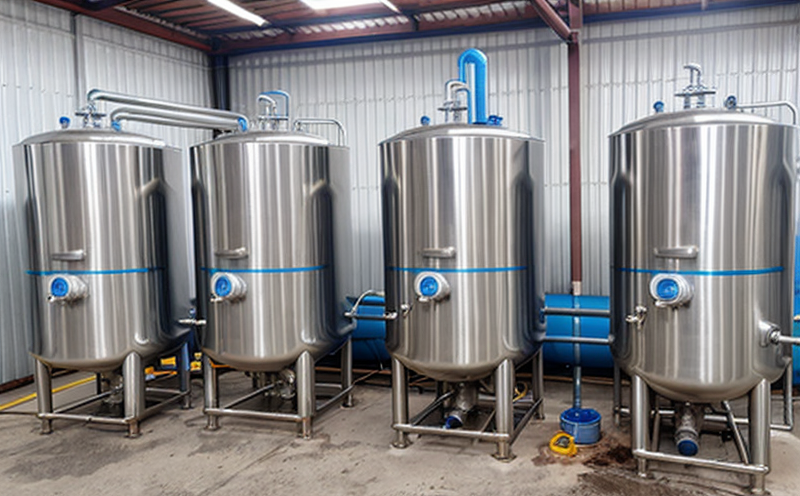ASTM D515 Orthophosphate Test in Boiler Water
The ASTM D515 standard method is widely recognized and used to determine the concentration of orthophosphate in boiler water. This test plays a crucial role in ensuring optimal boiler performance, preventing scale formation, reducing corrosion, and maintaining efficient heat transfer within industrial boilers.
Orthophosphate acts as a key component in boiler water treatment because it provides a protective layer by forming a stable, insoluble calcium phosphate film on metal surfaces. This prevents the buildup of scale, which can lead to reduced efficiency and increased energy consumption. Additionally, orthophosphate helps control corrosion, ensuring that boilers remain operational for longer periods without significant maintenance.
The ASTM D515 test is essential in industries such as power generation, manufacturing, and petrochemicals where boiler systems are integral to daily operations. Compliance with this standard ensures that water quality is maintained at optimal levels, which can lead to substantial cost savings in the long run by minimizing equipment downtime and extending asset life.
The testing procedure involves several steps, including sample preparation, titration using a known solution of ammonium molybdate, and calculation of orthophosphate concentration based on the volume of acid added. The results are typically reported as mg/L (milligrams per liter) of phosphate in the boiler water.
Accurate measurement is critical for this test, as even small variations can affect boiler performance significantly. Laboratories equipped with precision titration equipment and skilled analysts ensure reliable and consistent results.
| Sample Preparation | Titration Process | Calculation Method |
|---|---|---|
| Boiler water samples are collected from various points within the system to ensure a representative sample. Samples should be stored in acid-washed containers and kept cool. | The titration process involves adding a known solution of ammonium molybdate to the sample until a characteristic blue color appears, indicating the endpoint of the reaction. | The concentration of orthophosphate is calculated based on the volume of acid added during the titration. The formula used for calculation can be found in ASTM D515. |
- Ensure proper sample handling to avoid contamination.
- Use calibrated and accurate titration equipment.
- Perform calibration checks regularly to maintain precision.
The ASTM D515 test is a vital tool for maintaining boiler water quality, which in turn supports the broader goal of industrial sustainability. By preventing scaling and corrosion, this test contributes significantly to operational efficiency and environmental responsibility.
Industry Applications
The ASTM D515 orthophosphate test is particularly relevant for industries that rely heavily on boiler systems. Here are some key applications:
- Power Generation: Ensuring efficient and safe operation of boilers in power plants.
- Manufacturing: Maintaining optimal water quality in industrial processes to enhance efficiency.
- Petrochemicals: Protecting critical equipment from scaling and corrosion, which can lead to costly downtime.
| Industry Sector | Critical Equipment Protected | Main Benefits of Testing |
|---|---|---|
| Power Generation | Boilers and heat exchangers | Prevents scaling, reduces maintenance costs, ensures compliance with regulatory standards. |
| Manufacturing | Boiler systems in production facilities | Maintains water quality, enhances operational efficiency, extends equipment life. |
| Petrochemicals | Critical process boilers and heat exchangers | Avoids scaling issues, reduces corrosion risks, ensures regulatory compliance. |
These applications highlight the importance of regular testing to ensure that boiler water is maintained at optimal conditions. Proper orthophosphate levels are key to preventing scaling and corrosion, which can lead to significant operational disruptions if left unchecked.
Why Choose This Test
The ASTM D515 orthophosphate test is an essential tool for maintaining boiler water quality. Here are several reasons why you should choose this test:
- Accurate Measurement: The test provides precise measurements of orthophosphate concentration, ensuring that the right amount of phosphate is present in the boiler water.
- Prevent Scale Formation: By maintaining optimal levels of orthophosphate, scaling can be minimized, which prevents reduced heat transfer efficiency and equipment damage.
- Control Corrosion: The protective film formed by orthophosphate helps prevent corrosion, extending the life of boiler components.
- Compliance with Standards: This test ensures compliance with international standards such as ASTM D515, which is widely recognized in the industry.
- Economic Benefits: Regular testing can lead to cost savings by reducing maintenance costs and avoiding costly downtime due to equipment failure.
The ASTM D515 test is a reliable method for monitoring orthophosphate levels in boiler water, providing peace of mind that your industrial processes are running efficiently and safely.
Customer Impact and Satisfaction
The ASTM D515 orthophosphate test significantly impacts customer satisfaction by ensuring the highest quality standards in boiler water management. Here’s how it affects customers:
- Operational Efficiency: By preventing scaling and corrosion, this test ensures that boilers operate at peak efficiency.
- Extended Equipment Life: Proper orthophosphate levels help protect equipment from damage, extending its operational lifespan.
- Cost Savings: Reduced maintenance costs and avoided downtime lead to significant financial benefits for customers.
- Regulatory Compliance: Ensuring adherence to international standards such as ASTM D515 helps customers meet regulatory requirements easily.
Customers can trust that the ASTM D515 test provides reliable results, contributing to a safer and more efficient industrial environment. This ensures long-term satisfaction and confidence in boiler water management practices.





